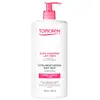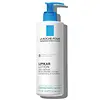Topicrem Ultra-Moisturizing Body Milk Versus La Roche-Posay Lipikar Daily Repair Moisturizing Lotion
What's inside
What's inside
 Key Ingredients
Key Ingredients

 Benefits
Benefits

 Concerns
Concerns

 Ingredients Side-by-side
Ingredients Side-by-side

Water
Skin ConditioningParaffinum Liquidum
EmollientGlycerin
HumectantCetearyl Ethylhexanoate
EmollientUrea
BufferingIsopropyl Isostearate
EmollientCera Alba
EmollientPalmitic Acid
EmollientStearic Acid
CleansingGlyceryl Stearate
EmollientPEG-100 Stearate
Isopropyl Myristate
EmollientPhenoxyethanol
PreservativePolyacrylamide
Polysorbate 60
EmulsifyingC13-14 Isoparaffin
EmollientCarbomer
Emulsion StabilisingChlorphenesin
AntimicrobialSodium Hydroxide
BufferingLaureth-7
EmulsifyingParfum
MaskingLimonene
PerfumingLinalool
PerfumingBenzyl Benzoate
AntimicrobialBenzyl Salicylate
PerfumingHexyl Cinnamal
PerfumingHydroxyisohexyl 3-Cyclohexene Carboxaldehyde
MaskingButylphenyl Methylpropional
PerfumingAlpha-Isomethyl Ionone
PerfumingHydroxycitronellal
PerfumingWater, Paraffinum Liquidum, Glycerin, Cetearyl Ethylhexanoate, Urea, Isopropyl Isostearate, Cera Alba, Palmitic Acid, Stearic Acid, Glyceryl Stearate, PEG-100 Stearate, Isopropyl Myristate, Phenoxyethanol, Polyacrylamide, Polysorbate 60, C13-14 Isoparaffin, Carbomer, Chlorphenesin, Sodium Hydroxide, Laureth-7, Parfum, Limonene, Linalool, Benzyl Benzoate, Benzyl Salicylate, Hexyl Cinnamal, Hydroxyisohexyl 3-Cyclohexene Carboxaldehyde, Butylphenyl Methylpropional, Alpha-Isomethyl Ionone, Hydroxycitronellal
Water
Skin ConditioningButyrospermum Parkii Butter
Skin ConditioningGlycerin
HumectantSorbitan Stearate
EmulsifyingParaffinum Liquidum
EmollientNiacinamide
SmoothingVitis Vinifera Seed Oil
EmollientAluminum Starch Octenylsuccinate
AbsorbentDimethicone
EmollientCera Alba
EmollientSorbitan Tristearate
EmulsifyingCarbomer
Emulsion StabilisingSodium Hydroxide
BufferingPoloxamer 338
EmulsifyingAmmonium Polyacryloyldimethyl Taurate
Emulsion StabilisingDisodium EDTA
Sucrose Cocoate
EmulsifyingCaprylyl Glycol
EmollientCitric Acid
BufferingT-Butyl Alcohol
PerfumingCetyl Palmitate
EmollientBHT
AntioxidantPentaerythrityl Tetra-Di-T-Butyl Hydroxyhydrocinnamate
AntioxidantChlorhexidine Digluconate
AntimicrobialWater, Butyrospermum Parkii Butter, Glycerin, Sorbitan Stearate, Paraffinum Liquidum, Niacinamide, Vitis Vinifera Seed Oil, Aluminum Starch Octenylsuccinate, Dimethicone, Cera Alba, Sorbitan Tristearate, Carbomer, Sodium Hydroxide, Poloxamer 338, Ammonium Polyacryloyldimethyl Taurate, Disodium EDTA, Sucrose Cocoate, Caprylyl Glycol, Citric Acid, T-Butyl Alcohol, Cetyl Palmitate, BHT, Pentaerythrityl Tetra-Di-T-Butyl Hydroxyhydrocinnamate, Chlorhexidine Digluconate
Ingredients Explained
These ingredients are found in both products.
Ingredients higher up in an ingredient list are typically present in a larger amount.
Carbomer is a polymer of acrylic acid. Its main role is to create a gel consistency.
A high amount of carbomer can cause pilling or balling up of products. Don't worry, most products contain 1% or less of carbomer.
Cera alba is beeswax, or the wax used by bees to make honeycombs. It is a texture-enhancer and emollient. A study from 2003 found beeswax to be a stronger emollient than ingredients such as petroleum jelly.
As an emollient, beeswax helps hydrate the skin by creating a barrier on top. This barrier traps moisture in.
Emulsifiers help prevent ingredients from separating. This helps create consistent texture.
The structure of beeswax is mainly long-chain alcohols and the esters of fatty acids.
There are three types of beeswax: yellow, white, and absolute. Yellow is pure beeswax taken from the honeycomb. White beeswax is created by filtering or bleaching yellow beeswax. Absolute beeswax is created by treating beeswax with alcohol. Beeswax used in cosmetics are purified.
Beeswax has been used throughout history and even in prehistoric times. Some common uses for beeswax still used today are making candles, as a waterproofing agent, and polish for leather.
Learn more about Cera AlbaGlycerin is already naturally found in your skin. It helps moisturize and protect your skin.
A study from 2016 found glycerin to be more effective as a humectant than AHAs and hyaluronic acid.
As a humectant, it helps the skin stay hydrated by pulling moisture to your skin. The low molecular weight of glycerin allows it to pull moisture into the deeper layers of your skin.
Hydrated skin improves your skin barrier; Your skin barrier helps protect against irritants and bacteria.
Glycerin has also been found to have antimicrobial and antiviral properties. Due to these properties, glycerin is often used in wound and burn treatments.
In cosmetics, glycerin is usually derived from plants such as soybean or palm. However, it can also be sourced from animals, such as tallow or animal fat.
This ingredient is organic, colorless, odorless, and non-toxic.
Glycerin is the name for this ingredient in American English. British English uses Glycerol/Glycerine.
Learn more about GlycerinParaffinum Liquidum is also known as liquid paraffin. It is a type of highly refined mineral oil.
Like other oils, Paraffinum Liquidum has emollient properties. Emollients help soothe and soften the skin. By creating a barrier to trap moisture within, emollients help keep your skin hydrated.
Paraffinum Liquidum does not irritate the skin and is non-comedogenic.
Learn more about Paraffinum LiquidumSodium Hydroxide is also known as lye or caustic soda. It is used to adjust the pH of products; many ingredients require a specific pH to be effective.
In small amounts, sodium hydroxide is considered safe to use. However, large amounts may cause chemical burns due to its high alkaline.
Your skin has a natural pH and acid mantle. This acid mantle helps prevent harmful bacteria from breaking through. The acid mantle also helps keep your skin hydrated.
"Alkaline" refers to a high pH level. A low pH level would be considered acidic.
Learn more about Sodium HydroxideWater. It's the most common cosmetic ingredient of all. You'll usually see it at the top of ingredient lists, meaning that it makes up the largest part of the product.
So why is it so popular? Water most often acts as a solvent - this means that it helps dissolve other ingredients into the formulation.
You'll also recognize water as that liquid we all need to stay alive. If you see this, drink a glass of water. Stay hydrated!
Learn more about Water